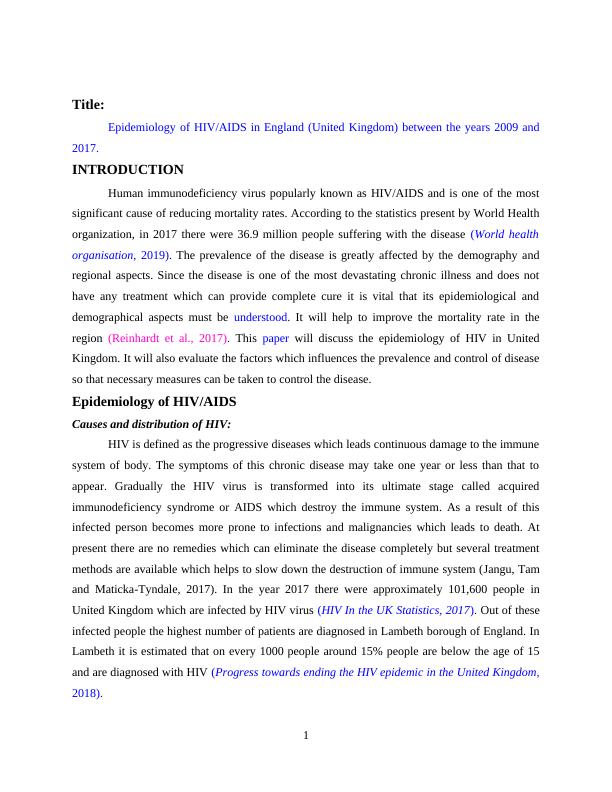Public Health Intelligence Sample Assignment
20 Pages4201 Words82 Views
Added on 2021-01-01
Public Health Intelligence Sample Assignment
Added on 2021-01-01
ShareRelated Documents
Public Health Intelligence

TABLE OF CONTENTSTitle: ................................................................................................................................................1INTRODUCTION ..........................................................................................................................1Epidemiology of HIV/AIDS............................................................................................................1Global presence of the disease ........................................................................................................4HIV prevalence and demography within UK .................................................................................6Factors influencing disease prevalence ...........................................................................................9Critical evaluation of secondary data source used ........................................................................11CONCLUSION .............................................................................................................................12REFERENCES .............................................................................................................................14

Title: Epidemiology of HIV/AIDS in England (United Kingdom) between the years 2009 and2017. INTRODUCTION Human immunodeficiency virus popularly known as HIV/AIDS and is one of the mostsignificant cause of reducing mortality rates. According to the statistics present by World Healthorganization, in 2017 there were 36.9 million people suffering with the disease (World healthorganisation, 2019). The prevalence of the disease is greatly affected by the demography andregional aspects. Since the disease is one of the most devastating chronic illness and does nothave any treatment which can provide complete cure it is vital that its epidemiological anddemographical aspects must be understood. It will help to improve the mortality rate in theregion (Reinhardt et al., 2017). This paper will discuss the epidemiology of HIV in UnitedKingdom. It will also evaluate the factors which influences the prevalence and control of diseaseso that necessary measures can be taken to control the disease. Epidemiology of HIV/AIDSCauses and distribution of HIV: HIV is defined as the progressive diseases which leads continuous damage to the immunesystem of body. The symptoms of this chronic disease may take one year or less than that toappear. Gradually the HIV virus is transformed into its ultimate stage called acquiredimmunodeficiency syndrome or AIDS which destroy the immune system. As a result of thisinfected person becomes more prone to infections and malignancies which leads to death. Atpresent there are no remedies which can eliminate the disease completely but several treatmentmethods are available which helps to slow down the destruction of immune system (Jangu, Tamand Maticka-Tyndale, 2017). In the year 2017 there were approximately 101,600 people inUnited Kingdom which are infected by HIV virus (HIV In the UK Statistics, 2017). Out of theseinfected people the highest number of patients are diagnosed in Lambeth borough of England. InLambeth it is estimated that on every 1000 people around 15% people are below the age of 15and are diagnosed with HIV (Progress towards ending the HIV epidemic in the United Kingdom,2018). 1

HIV is caused by the direct transmission of fluids such as semen, blood, breast milk andgenital secretions from the infected individual to others. The primary and common cause of HIVis sexual intercourse with an infected person. The transmission of blood can also cause thedisease. For instance, the people suffering from haemophilia requires blood and thus the supplyof infected blood to such patients can make them HIV prone. Pregnancy related HIVtransmission is also one of the alarming situations for the individuals. Since the disease hasultimate result of death it becomes essential that, the individuals who are not even born must beprotected from the infection. The HIV virus directly targets the immunity of human beings andthus body becomes vulnerable to cancer and other life threatening infections. The continuousdestruction of immune system makes individuals immunodeficient. Gradually the reducedfunctionality of immune cells functions which is measured by CD4 cell count results in AIDS(Acquired immunodeficiency syndrome) AIDS is the common term which refers to developmentof cancerous tissues and other clinical manifestations. Diagnosis and testing services: For the diagnosis of HIV enzyme immunoassays (EIAs) and other serological tests areperformed. A single test cannot provide the accurate diagnosis so these tests are performed incombination. Serological tests does detect the direct presence of HIV virus instead these testsdetermine the antibodies produced by healthy immune system (Davies, Ustianowski and Fox,2016). The most challenging aspect of HIV diagnosis is to detect its presence among childrenand infants. For the infants born from infected mothers in addition with serological testvirological test is also performed. Due to social stigma HIV testing services are not muchpreferred by people. There is need to promote voluntary testing. Mandatory testing are violationof human rights thus individuals must have self concern and awareness regarding this testingprocedures and needs. According to World health organisation HIV testing services must assurethat they follow principles such as confidentiality, informed consent, counselling, accuracy intest results and connection with the care and treatment services (World health organisation,2019). The HIV virus can also transmit from placenta or the breast milk (Handiso, Negash and Mekiso,2019). In order to avoid this severe risk, antiretroviral medications are provided to both femalesand infants so that vulnerabilities can be reduced. The long-term exposure of antiretroviralmedications can help the infected individuals to eliminate even the sexual transmission of the2

End of preview
Want to access all the pages? Upload your documents or become a member.
Related Documents
Communicable Diseases: Global HIV Epidemiology, Role of Agent, Host and Environmental Factorslg...
|18
|5405
|228
(PDF) HIV/AIDS prevention and treatmentlg...
|15
|4701
|417
About HIV/AIDS | Assignmentlg...
|12
|2067
|24
Assignment on Pathophysiology and Pharmacologylg...
|4
|799
|234
Communicable Diseases: Causes, Symptoms, Complications, and Managementlg...
|10
|2184
|311
Community Health And Population Assignmentlg...
|9
|1988
|12
